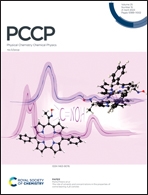The essential role of symmetry in understanding 3He chemical shifts in endohedral helium fullerenes†
Abstract
The 3He atom is an excellent NMR probe, particularly when enclosed in endohedral helium fullerenes. The 3He chemical shift, δ(3He), in fullerenes spans a range from ca. −50 to +10 ppm, and changes sensitively between different cages, isomers, and external substituents. Reduction of the fullerenes to anions changes the δ(3He) dramatically and unexpectedly, particularly for the most symmetric and also the most abundant C60 and C70 cages. While the 3He atom is shielded by ∼43 ppm upon charging the He@C60 to He@C606−, it is correspondingly deshielded by ∼37 ppm in the He@C70/He@C706− pair. Here, we show that such puzzling differences in δ(3He) relate to the high symmetry of the host fullerene cages. While similar shielding is induced at the 3He atom by the core orbitals of different cages, the symmetry of the cage allows or quenches large paramagnetic, i.e., deshielding orbital interactions of frontier orbitals upon charging of the cage, which is directly responsible for the large observed chemical shift range of endohedral 3He.



 Please wait while we load your content...
Please wait while we load your content...